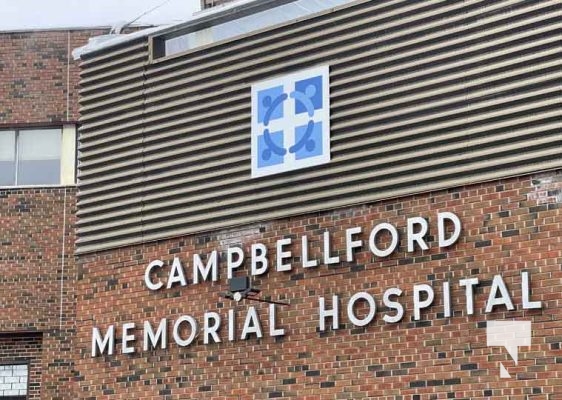Kelly Hubble was home in Springbrook with her two children when she started hemorrhaging blood from a miscarriage—and before becoming unconscious; she called her parents for help.
The ambulance brought Kelly to the Campbellford Memorial Hospital’s Emergency Department for urgent medical care.
“My daughter experienced a miscarriage, one of the most intimate and traumatizing experiences a woman and family can go through,” shared Catherine Holt, Kelly’s mother. “She received incredible, compassionate, professional care in the Emergency Department, but it was distressing that there was only a curtain between her having a miscarriage and the elderly patient beside her experiencing heart issues. We heard everything they were experiencing, and they heard everything we were experiencing.”
Catherine added: “We were shocked that my daughter and her family did not have privacy during such a traumatic experience.”
The Emergency Department’s physical shortcomings
Dr. Eshay Elia, Chief of the CMH Emergency Department (ED), is all too familiar with how the current ED infrastructure cannot keep pace with the demands of the growing community.
“The ED was designed when the hospital did not face, nor could anticipate, our current struggles of high volumes and increased acuity levels, which far exceed the infrastructure,” reflected Dr. Elia.
Dr. Elia points out that in addition to increased year-round residents, there has also been a boom in the cottage population, adding pressure on the rural Emergency Department. As a result, CMH expects the ED volumes in the 2022-23 fiscal year will be 120% of the 2020-21 volumes.
“The summertime can be quite busy, and there are many injuries due to recreational activities,” explained Dr. Elia. “Unfortunately, we only have a single trauma bay, so if we get more than one trauma at a time, we’re really stuck in terms of our infrastructure. On top of that, our ED is generally pretty packed because of high volumes and admissions rates, which can cause backflow into our trauma bay. Sometimes, we have our trauma bay taken up by a non-traumatic patient because of a lack of space, which is not ideal.”
When Emergency Care Quality Lead Heather Campbell first toured CMH’s Emergency Department (ED), she was struck by the infrastructure challenges.
“It’s remarkable how the ED team delivers high-quality care to patients despite working in an overcrowded space with serious limitations and challenges,” reflected Heather. “The environment is not conducive to providing emergency care, but our dedicated staff and physicians work extra hard to ensure high-quality patient care.”
Kelly Hubble’s ED experience is one striking example of patient privacy issues. In the ED, patients typically receive care in small cubicles sectioned off by only a curtain. When a patient arrives in serious condition at the hospital by ambulance, there is no dedicated ambulance entrance. Instead, paramedics must wheel patients through the main entrance by the waiting room, giving patients little privacy during a vulnerable experience.
The absence of private rooms also impacts infection control. For example, the current ED does not have a negative pressure room, which is essential when a patient has an airborne infectious disease. There are also only two patient washrooms for the whole department, which creates increased processes for the team to follow the standard isolation guidelines when caring for a patient with a suspected or confirmed infectious disease.
Dr. Elia adds that the CMH ED volume levels are so high that ambulances have offload delays because there is no space to bring the patient from the ambulance into the hospital.
“I’ve been working here since 2014, and it is not until recently that I’ve experienced an ambulance offload delay,” said Dr. Elia. “That just speaks to the fact that we don’t have enough rooms or a suitable layout to flow patients appropriately.”
Space limitations also mean that the triage nurse works in insufficient space for patient assessments without a dedicated anteroom or separate space for clinical assessments and tests like an ECG or bloodwork.
CMH has recently applied for funding to renovate the current ED to meet the infection control standards, such as adding a negative pressure room and an additional washroom.
Heather explained: “These renovations will assist in the interim, but they will not solve all the issues and capacity limitations with the physical space, like patient privacy and being undersized.”
How a Campus of Care will transform emergency care
“My daughter’s experience illustrates one critical reason why our community needs a redeveloped hospital: the lack of patient privacy,” said Catherine. “The care given by all the medical staff at CMH is amazing, friendly, kind, and high quality, but the state of the building itself has a tremendously negative effect on the patient’s right to privacy and the overall care experience.”
As part of the Campus of Care, the new ED will modernize emergency care by creating a larger space designed in a layout that supports growing patient volumes and acuity levels, patient privacy, comfort and dignity, and supports better patient flow and adherence to quality standards. The new, right-sized ED will include a dedicated triage space with a closed anteroom, more private patient rooms, at least two trauma bays, more waiting room space, and a dedicated area where paramedics can offload more patients safely and discretely.
“With the new Emergency Department, we have the opportunity to create a space that can keep pace with the growing patient volumes and acuity by designing a layout that places the healthcare workers in a central location so they can monitor every patient,” said Dr. Elia. “The new ED will allow for more patient rooms for privacy and optimal flow; multiple trauma bays; and better use of rooms by designating areas for patients awaiting results, for example.”
CMH has applied for a capital planning grant to redevelop the hospital as part of a Campus of Care that would create one location for a continuum of health services for residents. The redevelopment project would bring together the hospital, long-term care, affordable senior housing and services, mental health, primary care, and other healthcare services. CMH’s application for a capital planning grant to build a campus of care is pending approval from the Ministry of Health.
Contact your MPP to express your support for a new CMH as part of a Campus of Care.
Learn more at www.cmh.ca/redevelopment























